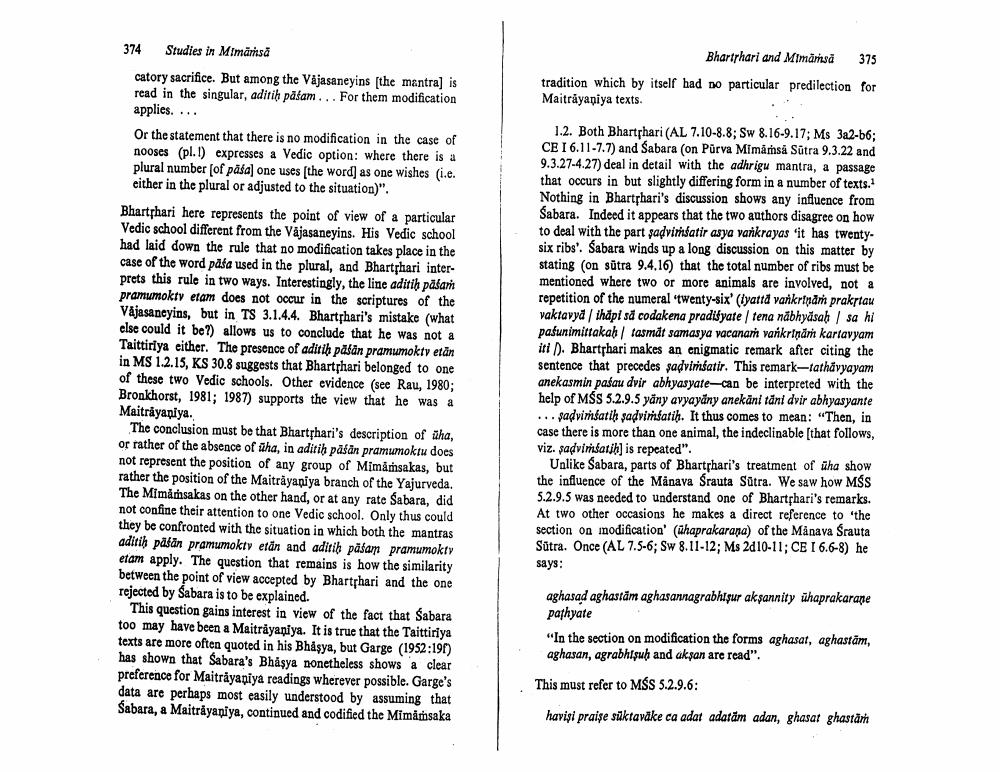________________
Bharthari and Mimāṁsā 375 tradition which by itself had no particular predilection for Maitrayaniya texts.
374 Studies in Mimarisa
catory sacrifice. But among the Vajasaneyins [the mantra) is read in the singular, aditih pašam... For them modification applies.... Or the statement that there is no modification in the case of nooses (pl.) expresses a Vedic option: where there is a plural number of paša one uses the word) as one wishes (.e. either in the plural or adjusted to the situation)".
Bharthari here represents the point of view of a particular Vedic school different from the Vajasaneyins. His Vedic school had laid down the rule that no modification takes place in the case of the word para used in the plural, and Bharthari interprets this rule in two ways. Interestingly, the line aditih pafari pramtumokty etam does not occur in the scriptures of the Vajasaneyins, but in TS 3.1.4.4. Bharthari's mistake (what else could it be?) allows us to conclude that he was not a Taittiriya either. The presence of adirib pasan pramumoktv etan in MS 1.2.15, KS 30.8 suggests that Bharthari belonged to one of these two Vedic schools. Other evidence (see Rau, 1980; Bronkhorst, 1981; 1987) supports the view that he was a Maitrāyapiya.
The conclusion must be that Bharthari's description of iha, or rather of the absence of ūha, in aditih påfan pramtumoktu does not represent the position of any group of Mimasakas, but rather the position of the Maitråyaniya branch of the Yajurveda. The Mimasakas on the other hand, or at any rate Sabara, did not confine their attention to one Vedic school. Only thus could they be confronted with the situation in which both the mantras aditih pasan pramumokty etän and aditib pašam pramumokty etam apply. The question that remains is how the similarity between the point of view accepted by Bharthari and the one rejected by Sabara is to be explained.
This question gains interest in view of the fact that Sabara too may have been a Maitriyaniya. It is true that the Taittiriya texts are more often quoted in his Bhåşya, but Garge (1952:191) has shown that Sabara's Bhåşya nonetheless shows a clear preference for Maitrayaniya readings wherever possible. Garge's data are perhaps most easily understood by assuming that Sabara, a Maitråyaniya, continued and codified the Mimasaka
1.2. Both Bharthari (AL 7.10-8.8; Sw 8.16-9.17: Ms 3a2-b6; CEI 6.11-7.7) and Sabara (on Purva Mimämsä Sutra 9.3.22 and 9.3.27-4.27) deal in detail with the adhrigu mantra, a passage that occurs in but slightly differing form in a number of texts. Nothing in Bharthari's discussion shows any influence from Sabara. Indeed it appears that the two authors disagree on how to deal with the part sadvimatir asya vankrayas 'it has twentysix ribs'. Sabara winds up a long discussion on this matter by stating (on sutra 9.4.16) that the total number of ribs must be mentioned where two or more animals are involved, not a repetition of the numeral twenty-six' (iyatta vankrid prakrtau vaktavya / ihapi sa codakena pradifyate / tena nābhyasah / sa hi pafunimittakah/ tasmdt samasya vacana vankrinär kartavyam iti ). Bharthari makes an enigmatic remark after citing the sentence that precedes sadvimbatir. This remark-athavyayam anekasmin pasau dvir abhyas yate-can be interpreted with the help of MSS 5.2.9.5 yany avyayany anekäni täni dvir abhyasyante ... sadvirfatih sadvimfatih. It thus comes to mean: "Then, in case there is more than one animal, the indeclinable (that follows, viz. sadvinfatih) is repeated".
Unlike Sabara, parts of Bharthari's treatment of üha show the influence of the Månava Srauta Sutra. We saw how MSS 5.2.9.5 was needed to understand one of Bharthari's remarks. At two other occasions he makes a direct reference to the section on modification' (thaprakarana) of the Mänava Srauta Sutra. Once (AL 7.5-6; Sw 8.11-12; Ms 2010-11; CEI 6.6-8) he says:
aghasad aghastăm aghasannagrabhtsur aksannity ühaprakarare pathyate "In the section on modification the forms aghasar, aghastam, aghasan, agrabhtsuh and akşan are read"
This must refer to MŚS 5.2.9.6:
havisi praise süktavake ca adat adatām adan, ghasat ghastan




